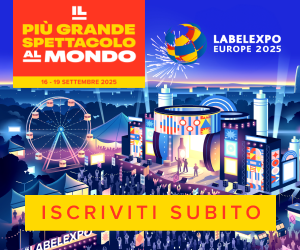 The premier B2B labeling event highlighted the major trends orienting the R&D of machinery, equipment and materials suppliers, starting with hybridizing technologies to create lines with unprecedented flexibility and productivity.
The premier B2B labeling event highlighted the major trends orienting the R&D of machinery, equipment and materials suppliers, starting with hybridizing technologies to create lines with unprecedented flexibility and productivity.
Labelexpo Europe celebrates its thirty-fifth anniversary (Brussels, 29 September – 2 October 2015) with an absolute record attendance of 35,739 visitors, a 12.4% increase over the previous edition of 2013, and 650 exhibitors compared to the 600 of two years ago, over a total surface area of 34,566 square meters, an increase of +11.65%. Additionally, the operators from abroad represent 19.6% of the total, hailing from 146 countries – especially Germany, France, Italy, Belgium and the UK, but also Asia, the Americas and Africa -, thus marking a high international presence.
The major labeling event (organized by Tarsus along with other Labelexpo affiliates around the world), which at first seemed to begin in slow motion, after the contemplative first day then resumed its usual liveliness and, according to initial feedback, instigated the usual bustle of encounters, demos, contracts (yes, sales were made at the fair).
But although positive, this is not “the” news of an event that serves a sector characterized by constant and projected growth, such as labeling is. Labelexpo Europe 2015 was even more exciting as a showcase of trends: to be clear, nothing particularly surprising, but forceful as only happens when things come to fruition after a long gestation period. In this case, there wasn’t a stand that wasn’t talking about digital, hybrid machinery or packaging.
Names and last names. The organizers list the main novelties: the Optima 820 printer for labels and packaging by Soma Engineering and the Gallus DCS 340 modular digital converting system – an inkjet printing module integrated with a Gallus, in such a way combining the state of the art in digital printing with the benefits of conventional printing. But the official list of outstanding solutions brought to the fair is long and includes new digital printers from large manufacturers like EFI, Epson and Screen, the HP Indigo 20000 and WS6800, the Mark Andy Digital Series (along with the Performance Series P4), and MPS and Nilpeter debuts in conventional hybrid and digital printing. A British colleague estimated around 20 established narrow web machine builders working on these two technology streams – and it will be worth the effort of deciphering the differences (which are there) in terms of print resolution and setup speed, print head type, layout rationale, the ingenuity of equipment and accessories and workflow effectiveness…
The short list would not be complete without the name of a renowned Italian manufacturer – Omet – which in its turn presented a series of hybrid and digital machines that are sure to pique the interest of operators, as well as, for other reasons, another dinamic Italian concern, recently integrated into a large Swiss group as its narrow web arm (Nuova Gidue was at the entrance of pavilion 11 with its “Bobst red” stand) .
But there were many solutions on offer, each promising in different ways. An unusual hybrid, for example, in the field of UV, with which GEW won one of this year’s Labelexpo Awards, a piece of equipment capable of using, as needed, both arc lamps and LED, with simplicity and energy efficiency.
Or the first Digifast One digital finishing unit by Prati, presented at the fair and acquired by the dynamic and lively labeler Nuceria, the first to invest in the resulting competitive advantage. Or still – in terms of materials – the foils with extraordinary optical and visual properties presented by Kurz (in Italy through Luxoro) as an “appetizer” for the major launches scheduled for Luxe Pack and Simei…
Demos and meetings. One of the characteristics of Labelexpo is the setup of theme areas where producers can give demos live. This year, Packprint Workshop Xeikon processed folding cartons, and Nilpeter illustrated the functionality of its FA* for flexo printing of flexible packaging. At Smart Packaging Lab, active and smart packaging were discussed, with contributions by Avery Dennison, Blippar, EyeSee and Seido Systems, while the new Linerless Trail served as a venue for showcasing the advantages of linerless labels developed by a series of partners (Maan Engineering, Appvion, Henkel, MPS, Ravenwood Packaging, Sato and Bostik).
Supply chain partnership found fertile ground at this event: even more than elsewhere, suppliers and users are engaged in co-marketing, hosting at their own stands complementary systems from others, in such a way multiplying their own visibility and showing more effectively the single component’s role in a wider workflow. This was confirmed at the end of the event by Doug Jones, vice president of global marketing for Apex International, which supplied its cylinders for live demos by Bobst, Omet, Soma, MPS and Lombardi: «It’s partly thanks to them that during the fair we managed to secure numerous large orders and register nearly 20% more sales than at the last Labelexpo».
Labelexpo, then, confirms its pragmatic approach to promoting effective partnerships and prioritizes demos and workshops over classic conventions, with a (partial) exception.
This year at Brussels, the European federation of flexographic printing gathered to create an information-packed conference with opening remarks by its president Sante Conselvan (Atif), as well as the president of the Belgian/Flemish association in the role of host. The long view approach and creative energy of Conselvan and the most active experts at Atif have fostered a rebirth of the organization which is already yielding results, ahead of drupa.












